
Halosaccion glandiforme
Sea Sacs, Salt Sacs, Dead-Man’s Fingers
Port San Juan, British Columbia, Canada
10 June 2020
Collected at 11:35am PDT
Low Tide 1.6 feet at 11:15am PDT (measured at Port Renfrew Tidal Station)
Weather: 100% overcast, no precipitation, calm winds, calm sea, light swell, temperature 14˚C, relative humidity 92%.
Phase of Moon: Waning Gibbous (Previous Phase, Full Moon, 5 June 2020 at 12:12pm PDT: Next Phase, Third Quarter, 12 June 2020 at 11:23pm PDT.)
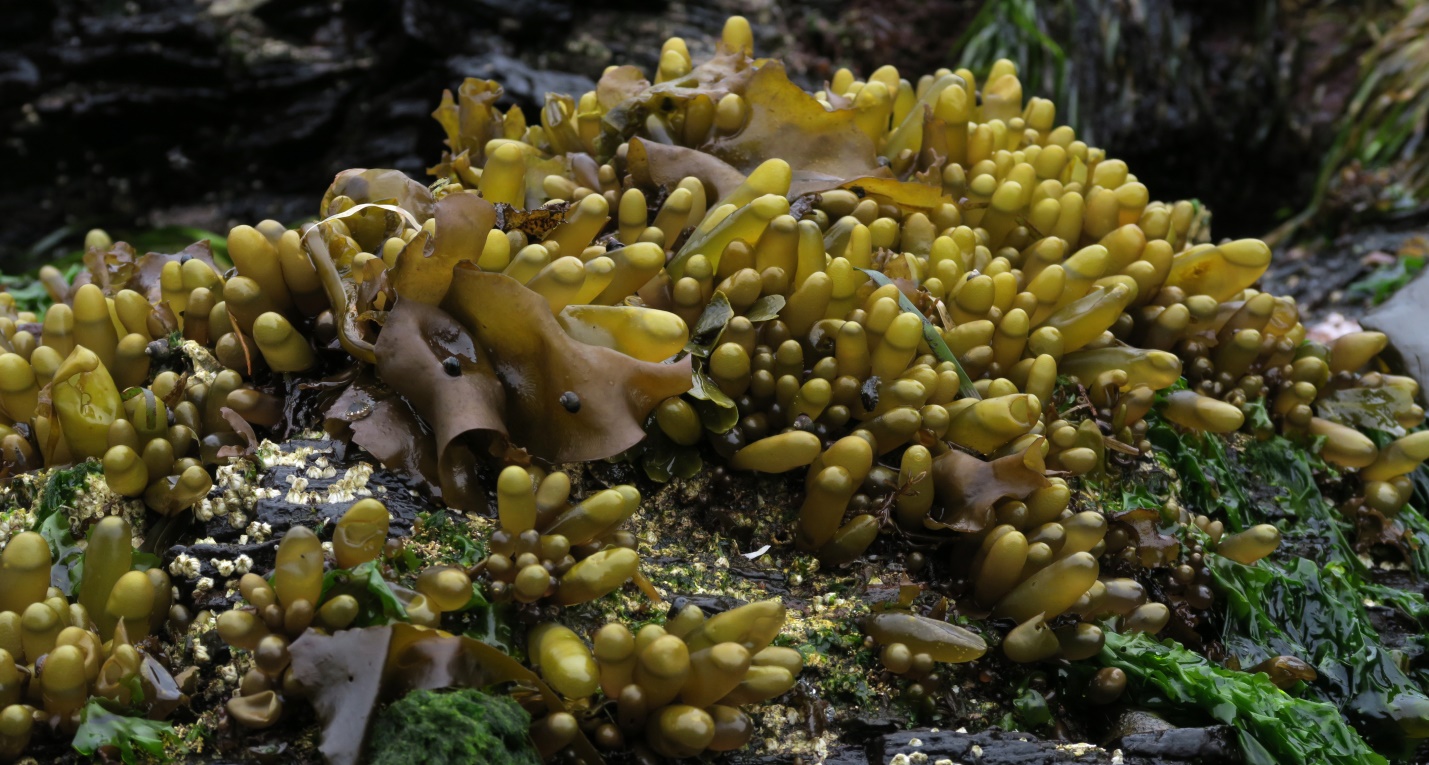
Figure 1: Halosaccion glandiforme, growing atop a crest of rock. Sea Sac spores have a preference for settling on rough surfaces and on also on the crests of rock rather than in the valleys or troughs. Port San Juan, B.C., Canada. June 10, 2020. Photo ID 27510 ©Seaweedwhisperings.com
In situ observations:
Person 1:
Phallic.
Clusters of helium balloons.
Some sacs deflated or broken.
Depend on group for identity or to reach maturity.
Masculine, no femininity.
Group sex – mechanical, not erotic.
Dildo, shape of.
Tiny base, few individual values. Identity based on what everyone can see, and expression of group values.
Growing on crest of rock for all to see.
No apparent leader, but there is a sense of order.
Chinese people all dressed alike.
Size doesn’t matter but must conform in shape.
Wants to conform / belong.
Broken individuals not conspicuous, overshadowed by uniformity and proliferation of group.
Look firm, but look like they would deflate easily.
Mafia; agreements cannot be broken, enforcement is brutal.
Lively, animated when wave washes over them.
When resting above tide, all are still. Waiting for commands?
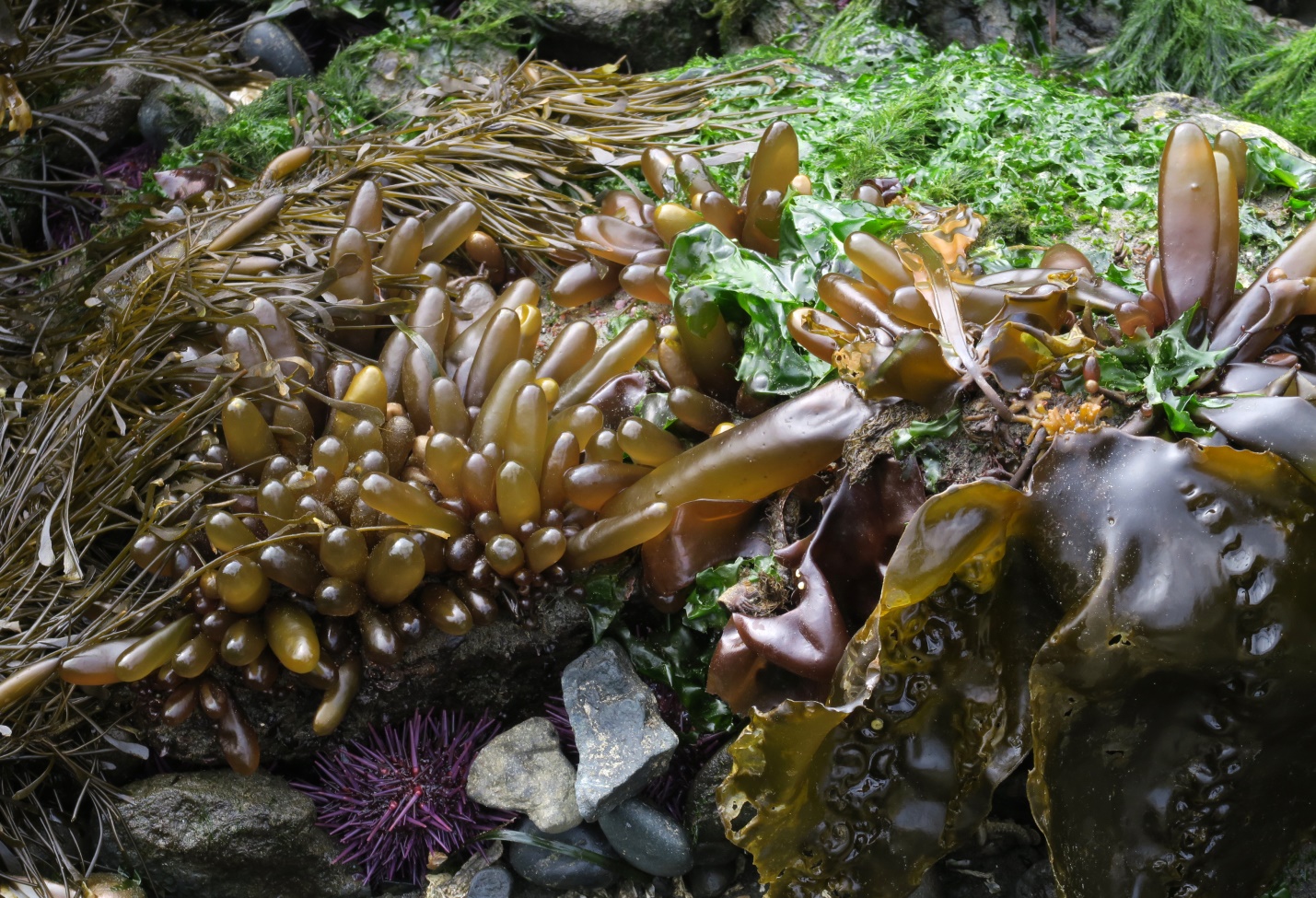
Figure 2: This mix of macroalgae includes a scattering of Sea Sacs. Mixed in nearby are two greens – Acrosiphonia coalita and Ulva lactuca. Another Red algae, Mazzaella spendens is not looking quite so ‘splendid’ at this low tide. Brown algae include a few pieces of Alaria marginata, Egregia marginata and Hedophyllum sessile. A sea urchin below the Sea Sacs looks particularly ‘threatening’ although it likely is grazing on other seaweeds of choice. Fishboat Bay, Juan de Fuca Strait, B.C., Canada. July 6, 2020. Photo ID 27511 ©Seaweedwhisperings.com
Person 2:
Groups of you growing right atop the ridge of bedrock.
Upright.
Reaching up.
Liquid within you – is it simply saltwater?
Some are larger, some smaller, some are tiny buds yet to take their size.
Bright yellow-green color.
Some tips are damaged / broken. How did that happen?
Most of your capsules are whole, entire; that seems somehow improbable.
So many of you all together – do you feel like a group..., like neighbors?
No, I don’t think you interconnect much one to the other.
But you all like the same habitat, you like sameness – period.
Rounded.
Rounded, elongated capsule of liquid.
Capsule – self-contained?
The liquid you hold within saves you from desiccation?
You have some noisy neighbors from other realms; barnacles snapping, gulls crying. Do you hear?
Incoming tide lifts you up and outgoing lays you down.
A small arc of movement, ranging from your anchor point.
Younger ones are more brown-y, touched by red.
Older ones are green touched by yellow.
Sitting near and gazing at the grouping of this seaweed I found myself for several minutes unable to think. It’s not that I was simply not thinking; it felt more like I lost my ability to think.
Eventually I thought of my senses and came first to sight & vision. I then squinted while looking at the grouping of Sea Sacs.
As I squint I see many, many rounded shapes – not circles, but everything has a round “feel” to it.
Unhurried.
Unphased.
Patient and totally OK to ‘hold’ here.
Green Rope, Green String Lettuce, Narrow Turkish Washcloth, seagrasses all grow near you. You don’t seem to care. Don’t even really notice.
The surf washing in and out of a nearby channel has a lulling sound – is this what lulled me out of thoughts / focus and into cool contentment? Is it the same for you, Sea Sacs?
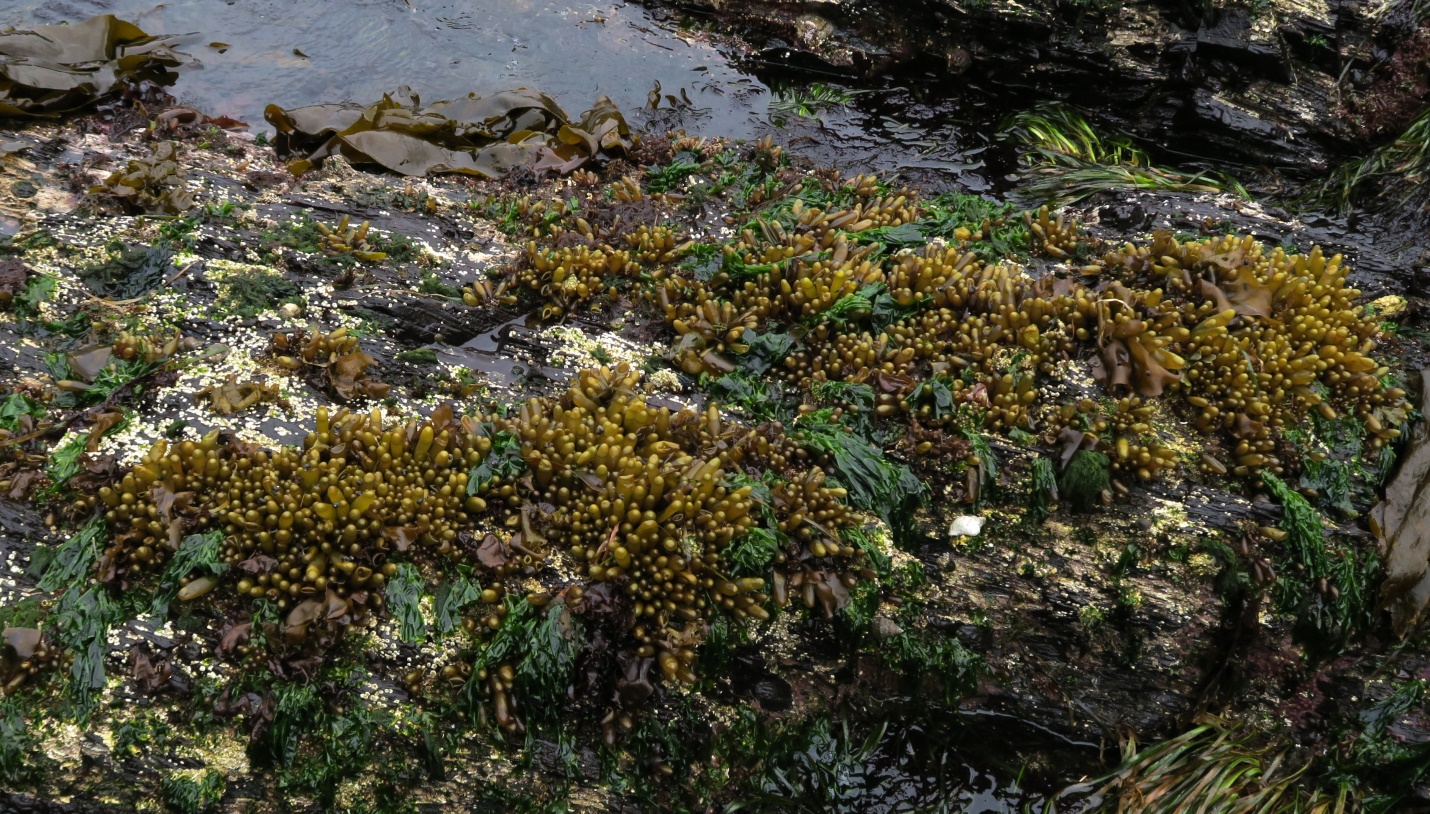
Figure 3: Halosaccion glandiforme is the predominant algae growing on a ridge of rock at the mid-intertidal zone. As a red alga, it looks surprisingly ‘yellow’. Port San Juan, B.C., Canada. June 10, 2020. Photo ID 27512 ©Seaweedwhisperings.com
Further Observations & Impressions:
Person 1:
Bobs buoyantly (in our basin filled with seawater).
Wants to be upright and erect.
Looks very unhappy when broken.
Popsicle.
Wants to retain form; bounces back to original cluster shape after being disturbed.
When squeezed gently it feels as though it might be gelatinous inside.
Skin feels thin but tough.
Air bubble in each sac (approximately 15% of volume) can move around, but seems to prefer to be at top end.
Smooth feel when rubbed against my face.
Expected a “pop” when I squeezed it, but there was no sound.
Don’t want to bite it for fear of being sprayed with an unknown substance from the sac’s interior.
Resisted trying to break the Sea Sac for many minutes, but finally relented.
Squeezed the sac – expected it to pop, but instead it squirted out a thin, long stream of salt water. I was surprised.
Tried to bite another sac for a taste. Unable to break the skin with my teeth. Kevlar?
Faint cucumber-like flavor.
Mostly what I got was a mouthful of saltwater.
Even when I squeezed a sac and it squirted out water it didn’t seem to lose its shape.
“Halosaccion” – a sac filled with the iodine water I had just experienced.
“Glandiforme” – looks like a gland.
“Sea Sac” – apt description of its looks.
Person 2:
When collected in the field, the individual capsules, elongated, tubular, round-tipped ‘stems’ had water in them.
Seeing them now in the observation bowl, I see the aspect of them being not “full” of water, but also partly encapsulating air which means the tips of the thalli float. The cylinder is both a storage canister for water and an air bladder for flotation.
I wonder if, left immersed for hours, would you fill up with water or would there always be some “air” still saved within.
The base of each sac / capsule is narrower – it tapers to a point near the holdfast. At this narrower section the color is deeper – darker red brown; at the rounded opposite tip the color is the lightest – a pale yellow-green.
So, its coloration is dark near the rocks / earth, and light near the sky.
No matter how tall the capsules get (the tallest ones in this area on this date were approximately 4 – 5 cm) it seems like there is an ideal diameter / length ratio to the sac.
The word “bubble” came to me in situ; it returns to me now as I see the stems floating, lifted in the water by their bubble of air held within.
Bubbles come up in another way. Between in situ observations and at home observations we paused for lunch. I had the desire to share a beer with Person 1 but I did not want any alcohol. I then thought I’d like some “bubbly” mineral water.
Bubbles, the concept of or desire for, is present for me with this alga.
This seaweed is simple in shape.
Simple geometry to your ellipsoid capsule.
Not ugly, not classy, yet distinctive and uniform.
It seems like your very small holdfast is composed of small, short branches.
I hear a squeaking hissing sound during the first few times when I squeeze a capsule / sac. The pressure has forced the air from your sac out through a tiny hole at the tip; then a thin thread of water shoots out until there is no more left inside your sac.
Touching the thalli, their surface feels smooth but not slippery.
There is a mildly porous quality to your exterior surface.
I wonder about the interior surface?
I cut one sac open with a knife. I made a lengthwise cut and the two halves instantly rolled inward like a tight scroll of paper.
I unrolled it to feel the interior surface. It is soft and has a slightly velvety texture.
If I touch the tip and tap down, there is a bounce – the tip depresses and then bounces back to form.
If I try to squeeze the sac even with a lot of pressure, it does NOT break. I had expected it to pop.
It is much stronger than it looks!
This is a tough little alga!
It seems only a hard blow or something sharp and cutting could “burst” your capsule.
I tried to bite a capsule and the salt water within squirted into my mouth, but the capsule didn’t break.
I had to chew with my molars, macerate a few times, and only then the capsule succumbed and was broken. Maybe those broken on the rocks were damaged by floating logs and other heavy debris.
Taste very faintly of iodine and slightly like cucumber.
The texture is tough!
Yes, you’re tough!
And there is little to recommend eating another piece of this seaweed.
No smell, unless torn, then there is a saltwater and slight iodine smell.
“Sea Sac” – yes, these are little sacs of seawater!
“Halosaccion” – I see “halo” in the name. Are you angelic? In situ, where the interior water line could be seen, a ring or “halo” is visible on each capsule.
“Saccion”
– starts with “sac” – so, perhaps means something like sacs
being a prime “way of being” or
“sacs are all” or “sacs
unto themselves”.
“Glandiforme” – what gland(s) might you resemble.
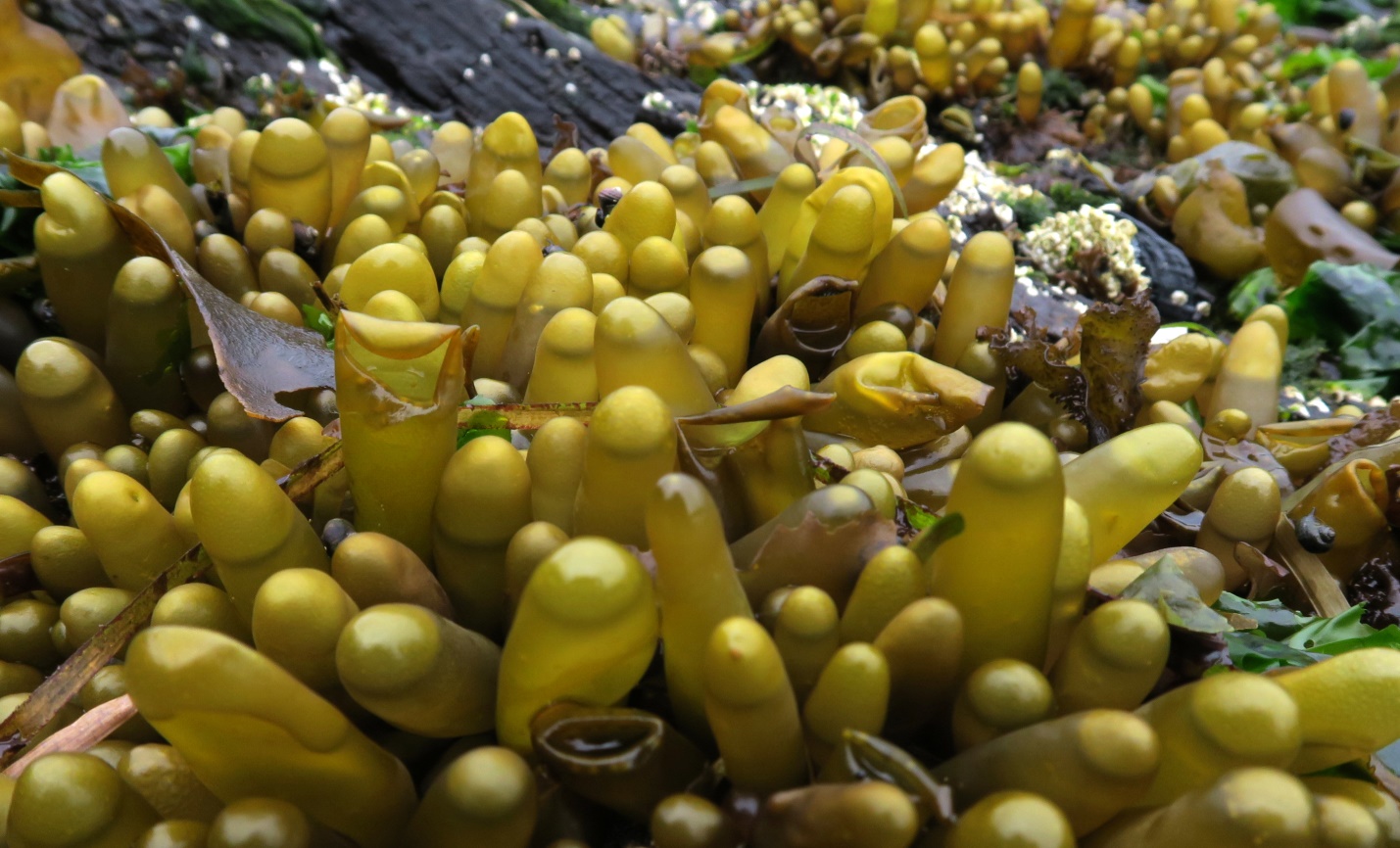
Figure 4: Broken and damaged Sea Sacs, Halosaccion glandiforme, are visible here in contrast to neighboring individuals that all have their ‘halos’ and ellipsoid forms intact. Port San Juan, B.C., Canada. June 10, 2020. Photo ID 27513 ©Seaweedwhisperings.com
Listening Further:
Person 1:
Solidarity, but “loyalty” is imposed. Made me think of politicians towing the party line.
Do what you’re told / commanded or you will be killed (mafia).
If you don’t conform you will be destroyed (physically, politically, or emotionally).
Want to conform – don’t want to be singled out as different, thus risking destruction.
Will rise again.
Defiant. Resistant.
Highly resistant to change.
I fell asleep sitting up while waiting for Person 2 to finish writing. Awakened with a surprising sound, “jrinng”, like a single loud chord strummed on a guitar. Was this a call to “attention” from the unseen leader?
I have a vision of a dance. Not the traditional type of dance where there is a lot of interpersonal interaction, but rather one of the more popular, contemporary dance styles – people crowded on a dance floor, each moving in their own world.
Person 2:
Going deeper? You don’t want to be / go deep, is that right, Halosaccion?
“No, you see, I like to float”, Halosaccion replies.
“Capsule” is the word I seem to prefer for this stem / thallus of seaweed.
Capsule – like a sea capsule...? A time capsule...? A space capsule...?
All is encapsulated within.
“This is my strategy”, Sea sacs says, “– encapsulate, hold within, be able to withstand changes of tide or circumstance unchanged!”
Things bounce off – don’t enter.
Pressure exerts its force, but I don’t succumb. [I find I want to speak in first person for Sea Sacs here]
My capsule completely serves my existence.
I grow in groups but the group outside my capsule means little to me.
They are there, nearby, and that is fine. But I don’t have the urge to interact with them. I can really only knock up against my nearest neighbor and I only just bounce off them, anyways.
I have no branches to intermingle, no lobes to enmesh or entangle.
I bounce off.
I am solo.
Solo in a group of others being solo, too!
Gasses sometimes expand within, but they find their escape route automatically. I don’t need to assist them.
I’m very stable.
I do grow, when young – grow until I reach my ideal size and form, but after that I am very stable, unchanging, doing little, actually doing almost nothing as an act of my own will – and feeling almost nothing, too.
Earlier I used the word “content” but I don’t think contentment enters in, for there really is nothing, no-thing; no thinking, no striving, no longing, no communicating, no pleasure, no pain, no action, no reaction.
A capsule of nothing!
NO-THING encapsulated!
What an odd concept – yet it fits this seaweed.
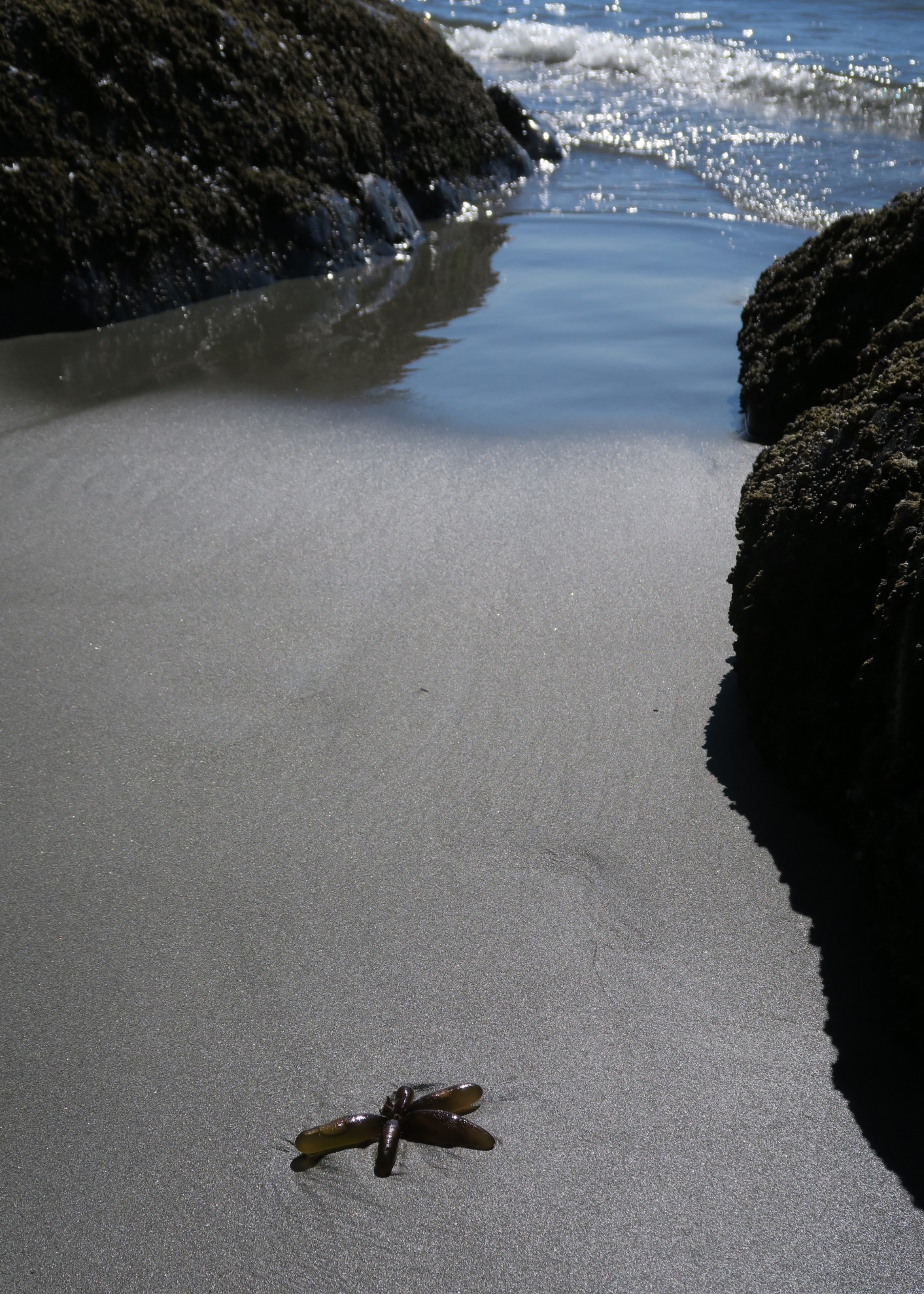
Figure 5: Not a common species to be found in “the drift”, this little cluster of Sea Sacs looks poised and ready to sail the Seven Seas. These sacs of algae encapsulate seawater and a mix of gases and therefore float very effectively. Seen alone like this on the beach, this photo also depicts something of the “solo” nature of the seaweed. Fishboat Bay, Juan de Fuca Strait, B.C., Canada. August 9, 2020. Photo ID 27514 ©Seaweedwhisperings.com
Returning specimens to sea:
We thought to return the seaweed specimens to the sea, but then looked at them in our bowls of saltwater and thought, “No hurry! They’re fine as they are!”
This is notable. With all other species to date we wanted to return them to the ocean in a timely and respectful way. With the Sea Sacs, we didn’t feel this. As I just thought of their name while writing this comment I realized, of course – there’s no returning to do – they have their own little “sea” within! There really IS no hurry. Each sac has/is a “sea unto itself”.
Later, when we did return these sturdy little Sea Sacs to the ocean, it occurred to us that we have not yet observed this alga washed ashore and deposited on the beach by the receding tide. This seaweed has no leafy blade, no structures that can be broken off or ripped from any main structure.
There is the main structure of the ‘sac’ and that is all.
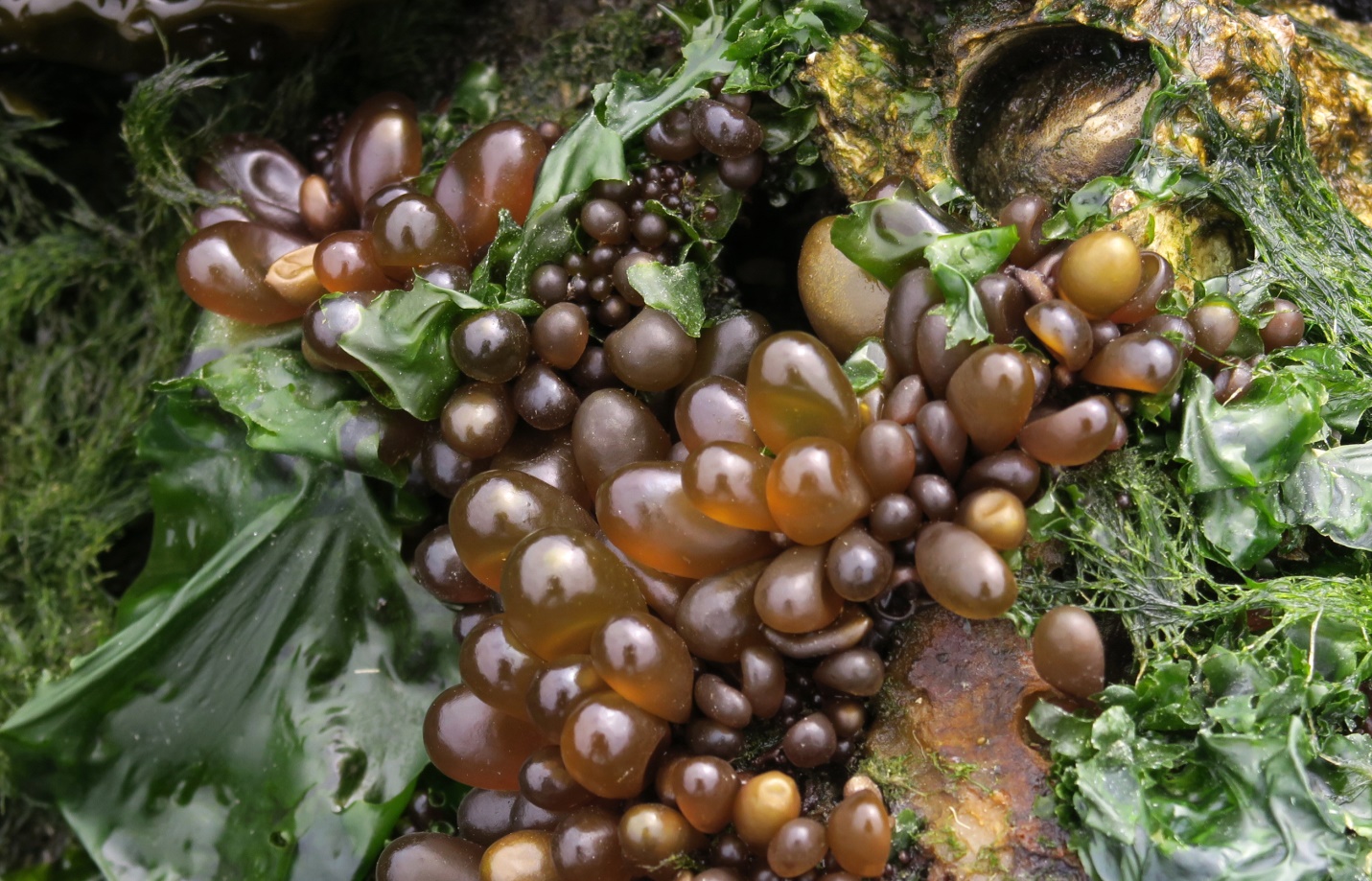
Figure 6: In this grouping of young Sea Sacs many individuals are showing their ‘red algal’ nature. The smallest ones are barely 3 to 5 mm in diameter and the larger ones are lengthening and lightening in color as they grow. Harling Point, Juan de Fuca Strait, B.C., Canada. June 23, 2020. Photo ID 27515 ©Seaweedwhisperings.com
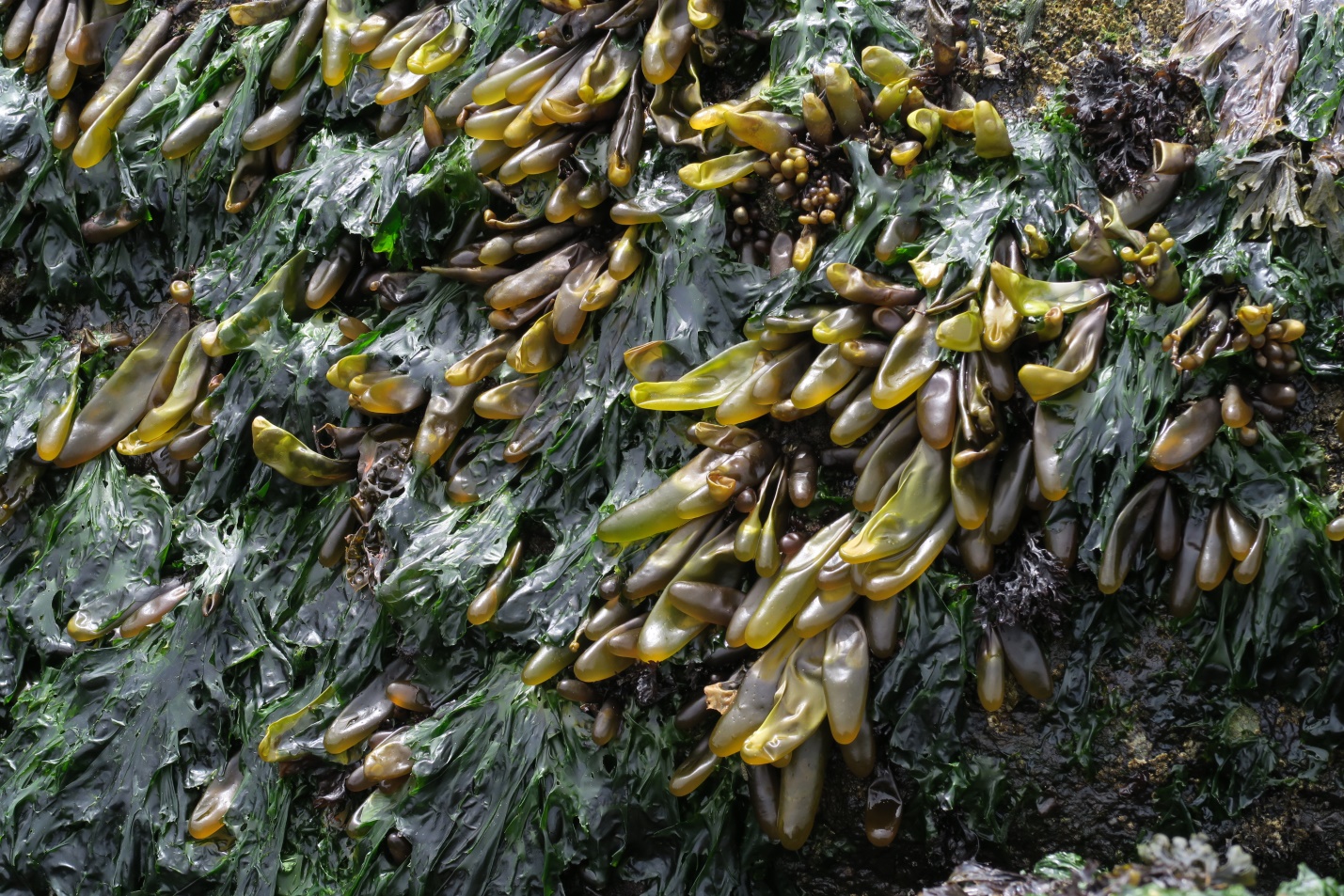
Figure 7: On this large rock face many Halosaccion glandiforme have reached considerable size, and with it, their phallic look is plain to see. The largest individuals here were 20 cm long or more. Younger Sea Sacs are growing adjacently. Harling Point, Juan de Fuca Strait, B.C., Canada. June 23, 2020. Photo ID 27516 ©Seaweedwhisperings.com
Discussion:
Sameness – uniformity.
Unexamined nothingness. That can be the problem…, you have nothing, but you also haven’t realized you have nothing.
There’s no thoughts.
You’re not thinking, therefore you can’t move in any particular direction, because you’re not even considering that there is direction.
You’re unable to think for yourself when there are no thoughts.
You can’t individuate.
Perhaps that is why uniformity, being the same, feels right.
Conform – so you can just be.
If you stand out, or differ by being taller or on the fringes you will not just “be”, you will be destroyed.
What ‘leader’ might call you to attention, out of your slumber?
It’s the leader, the force that will move you to evolve. This force would have to overcome the unchangeable nature of this seaweed.
In the bath later that night, Person 2 relaxed and allowed her arms to float alongside her body, buoyed up in the water – experienced how this is effortless. The feeling took her to the Sea Sacs and to recognizing how their ‘design’ is perfect for effortlessness and no work. The air bubble and the sea water encased within the sac simply obey the physical forces of nature. So while Sea Sacs do sit erectly on their holdfasts, they do so with no effort, no work.
Person 1 found the Sea Sacs to be phallic, very masculine. In our discussions Person 2 found Person 1 to be notably cut and dry about this seaweed. He didn’t entertain discussion on any point with tolerance, curiosity or passion (as had been typical in other Whisperings we’ve done).
With the Sea Sacs Person 1 had little or no emotion.
There is also the ‘no thinking’ aspect, so where is the intellect? Is there temptation to philosophize in the little capsules..., it felt like that was unlikely..., anything going on was beyond or very different from that.
It just is.
So with this seaweed, we were not talking about feelings or insights; it’s all about structure / order and effortlessly obeying the forces of nature, without physical awareness or being anchored to much of anything.
Not being anchored to much of anything... not connected to much on the earthly realm.
Capsules that seem self-sufficient – contained within themselves and engaged in something quite undetectable from the outside.
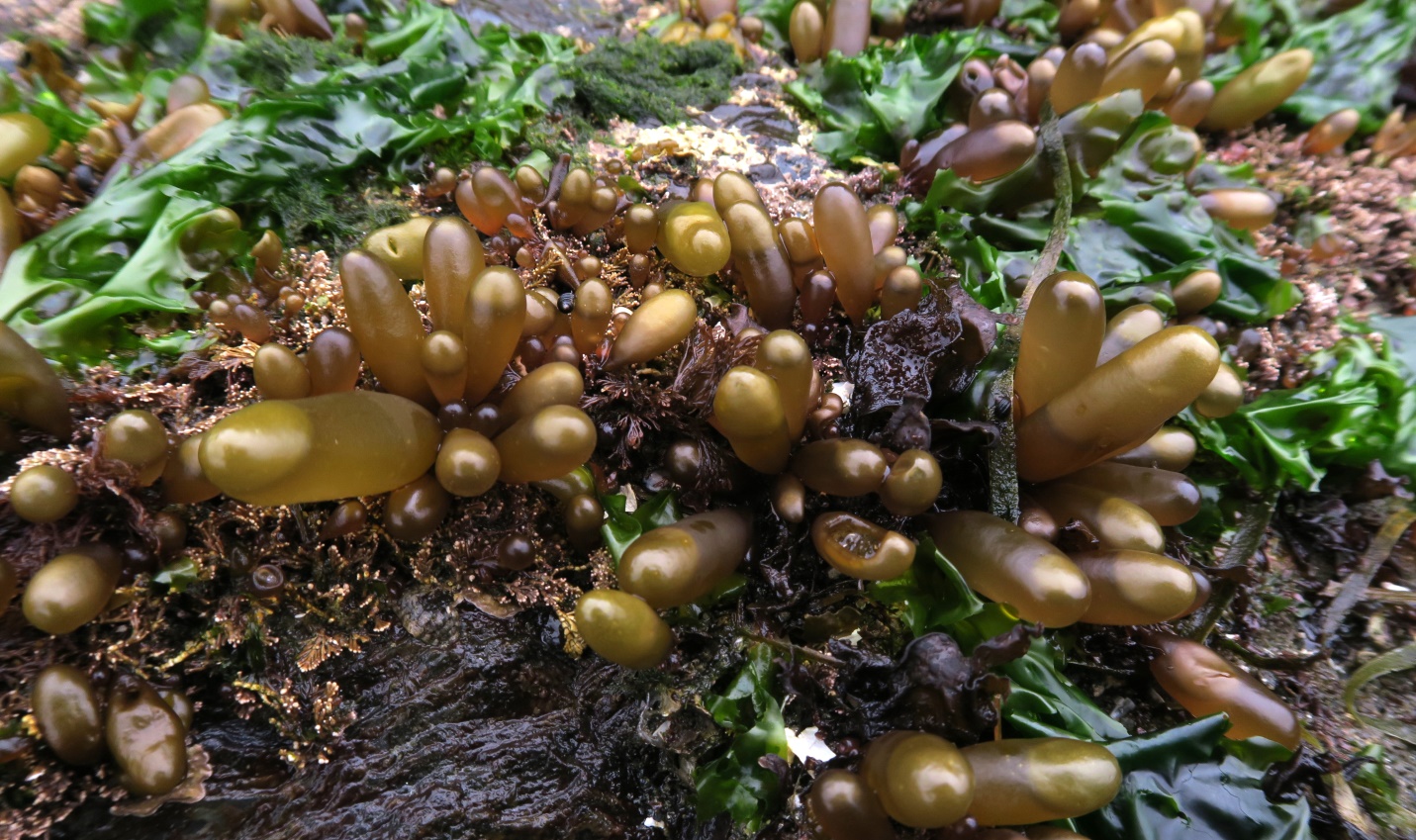
Figure 8: Halosaccion glandiforme is seen here at various ages / stages of growth and alongside colorful neighbors; intermixed are bits of Mastocarpus sp., Corallina vancouveriensis, Ulva lactuca and seagrasses. Port San Juan, BC. June 10, 2020. Photo ID 27517 ©Seaweedwhisperings.com
Biology & Natural History Information
Description:
Each individual alga is an almost perfect ellipsoid up to about 30 cm tall (though commonly is half that size or less) and about 2 cm wide. Young Sea Sacs are thin-walled but as they increase in size their bright purplish red color becomes progressively more bleached to pale greenish-yellow, especially at the tips. The outer surfaces of the sacs are smooth and shiny and at the upper third they are dotted with 5 to 15 tiny pores. These pores admit sea water to the sacs, which are filled to capacity except often for a bubble of oxygen at the tip that is formed by rapid photosynthesis. The bubble of gas within the sac helps hold it erect when immersed, and the internal water helps keep the sac cool and moist during low tide emersion. Water can seep out of the pores when the sacs are immersed, although air cannot enter.
Habitat:
This is an easily recognized mid to low intertidal species. It is an annual that grows in clusters on rocks or epiphytically on other algae such as Graceful coral Seaweed (Corallina vancouveriensis) and Black Pine (Neorhodomela larix). In areas of more protected waters it forms rather isolated patches, but in exposed outer coastal areas it can form extensive mats. Sea Sacs appear in early spring and then degenerate after spores are released in the fall.
World Distribution:
Bering Sea and Aleutian Islands, Alaska, to Point Conception, California; Kamchatka; Chukchi Sea; Russia.
Remarks:
Research has shown that three hours of exposure out of water is enough to kill sacs experimentally emptied of their water, but filled sacs survive. When re-immersed, the sacs re-inflate to the ellipsoidal form due to the elasticity of their walls, with sea water re-entering through the pores.
Each Sea Sac tapers to a short, weak stipe that is anchored to the rock with a small, discoidal holdfast. The stipe can be weak and still not break because the sacs have such an excellent hydrodynamic shape, and drag on the sacs by water currents is low.
The sac-like ‘foliose’ form of Halosaccion glandiforme are all either male gametophytes or tetrasporophytes as females are all microscopic.
Washington State studies have shown that Sea Sac spores have a strong preference for settling on rough surfaces (up to 98% of spores settled on the fine tips of projecting substrata rather than in the valleys between tips).
Studies on the west coast of Vancouver Island, British Columbia revealed that photosynthesis in sacs exposed by low tide was only half that of sacs immersed in sea water. The uptake of carbon dioxide from water held within the sac was almost 70% as much as that taken up from the air, and about 30% of that taken from sea water outside the sacs. It was concluded that the water held inside the sacs is a significant source of carbon dioxide for this alga.
Individuals collected from southern British Columbia/norther Washington State withstood a week of immersion in water at a temperature of 18˚C but died when placed in warmer water.
Sea Sacs are an often ignored edible, and they can be eaten raw or added to soups/stews. Aside from humans, they are eaten by limpets and black turban snails, which benefit from their high caloric value (4.12 Calories per gram of dry weight).
Gammarid amphipods sometimes chew a hole near the base of a Sea Sac, then enter the watery interior and use the sac as a protective residence; other microscopic nematodes use the interior of the sacs as shelter.
Classification:
Phylum: Rhodophyta
Class: Florideophyceae
Order: Palmariales
Family: Palmariaceae
Genus: Halosaccion
Species: Halosaccion glandiforme (S.G. Gmelin) Ruprecht 1850
Former name(s):
Ulva glandiformis S.G.Gmelin 1768; Halosaccion fucicola (Postels & Ruprecht) Kützing.
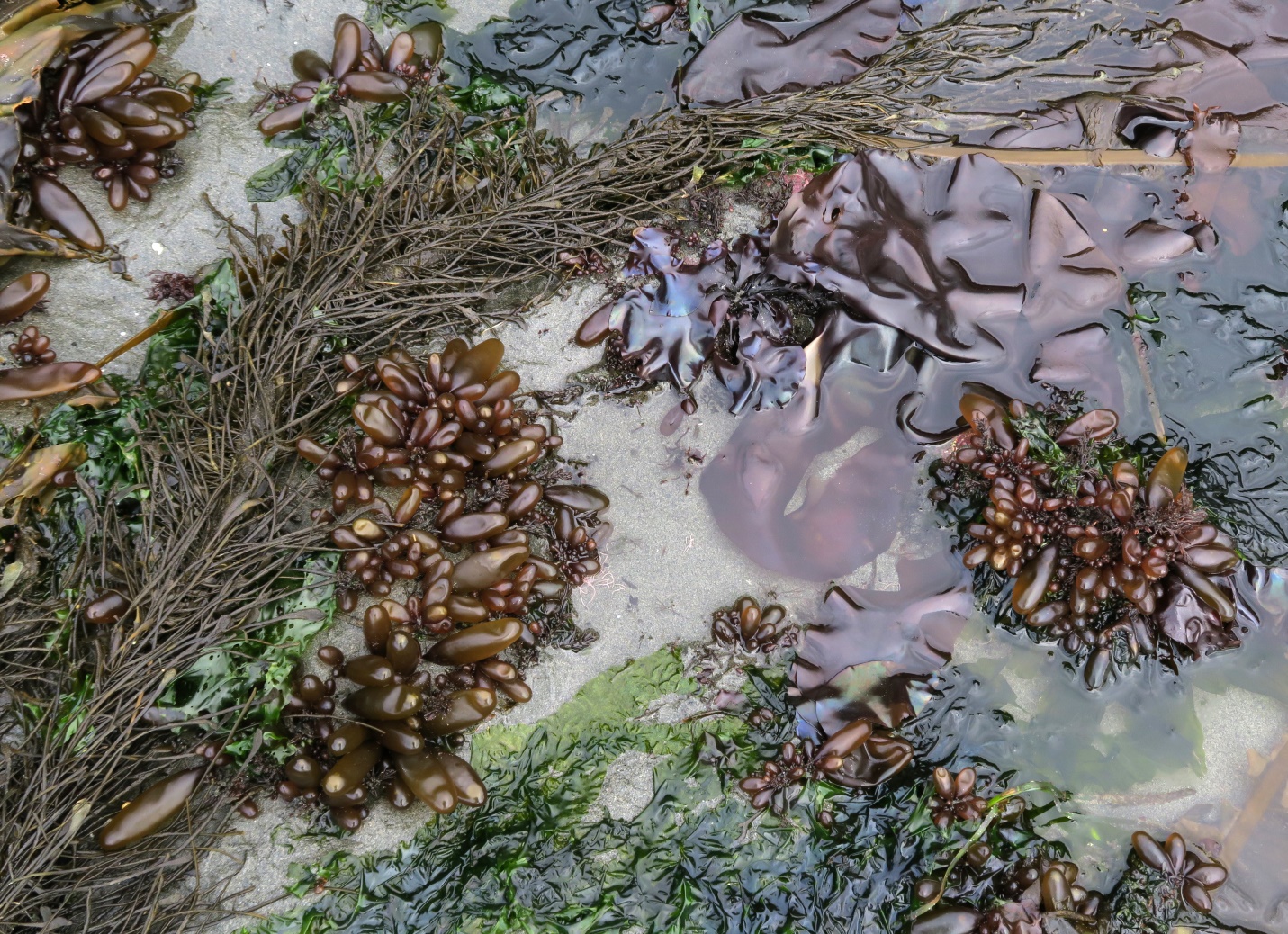
Figure 9: Viewed here amongst diverse other algae species, Halosaccion glandiforme holds its own and displays its rather different physical/morphological approach to life. While the substrate appears to be sandy, there are numerous rocks and cobbles that are partially buried in the sand – it is to these rocks that the Sea Sacs anchor themselves. Fishboat Bay, Juan de Fuca Strait, B.C., Canada. July 6, 2020. Photo ID 27518 ©Seaweedwhisperings.com
![]()